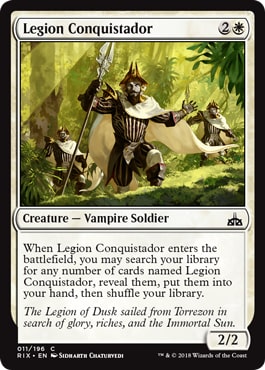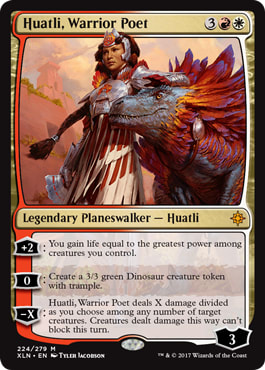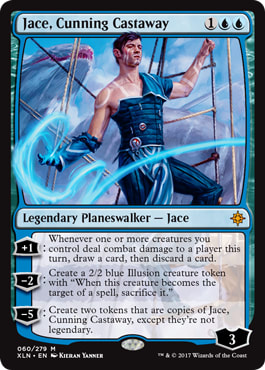I've never quite bought the idea that the promotion of a Magic set is part of that set's "story." That stuff is paratext — something that runs alongside the main text which might contribute meaning but isn't, like, the story. That's reserved for the novels, or the ebooks, or Magic Story, or whatever comes next in the cancellation chain. Oh, and the cards I guess? Though that's always been a bit weird and contentions, as the cards and stories have sometimes interacted weirdly. Maybe Jeff Grubb misreads some flavor text and suddenly Barl and Lord Ith are two different characters. Still, as much as we can say that there's a text and paratext in Magic, the cards and actual written stories seem to be inside the Text bubble, and promotion is firmly in Paratext.
Ixalan put that reading to the test, and man, I think I may have to reconsider.
To make sense of why, we've got to understand the two basic axioms at work with Ixalan as a set.
The first is that Magic's story is not just the story of the Gatewatch but is the story of entire worlds (and the countless smaller stories within). Magic, because of its basic nature as a card game full of various creatures and spells not looped into a "main" plot, tells geographical and historical stories.
The second is that once you make certain decisions about a plane like Ixalan, you've really got just two kinds of story you can tell, one pretty interesting (though not without its pitfalls), and one that's just . . . pretty bad. They are, at their heart, stories deeply colored by colonialism. It didn't have to be that way, but, well, when you populate a plane with Aztecs riding dinosaurs, and then throw conquistadors and pirates into the mix, it's just kind of unavoidable as a topic.
The two broad approaches, as I see it, are not, however, as straightforward as "do the Conquistadors win in this version of events" — the maybe more intuitive splitting point. No, beyond that I think the question is one of whether the native peoples in this scenario are treated as equally worthy of being narrative subjects, or whether they are merely observable objects for the perspective-holding "Western" factions. Is it possible for them to be explorers, or are they just part of the scenery to be explored?
It's a useful question I think because so many problems and other questions spin off of this question. Like: are all groups granted a complex political history, or are the natives we see simply part of an "ancient culture" that hasn't changed since the stone age? Are there factions, individuals, complex interests, or simply The Tribe, or, at most, the faction that likes the outsiders and the faction that hates them? Can there be more than one "native" civilization or is complex multiculturalism reserved for European nation state stand ins? Are the groups, in short, treated as having an equal humanity? Without delving too deeply into the various race and postcolonialist theories revolving around these questions, I think this should give some sense of how differing treatment becomes an issue.
It'd be pretty easy to blow off this critique as "political correctness," but that's just . . . wrong? It's just objectively incorrect. Once you start looking, opinions like "colonialism was actually good for the primitive colonized" are pretty bog standard, and the underlying theory of "primitive" and "civilized" cultures is everywhere. At an institution where I taught, one of our core Art History textbooks offered, as an example of "stone age culture" alongside 40,000 year old cave paintings, First Nations myths recorded in the late 1800s. This was a textbook, portraying two groups 42 MILLENNIA apart, on two different CONTINENTS, as basically having analogous (primitive, superstitious) beliefs. Acting like non-Europeans are a big primordial mass of Pre-Civilized, without their own deep history and changing politics, just isn't some politically incorrect, radical, outsider opinion.
And so. Those questions from a couple paragraphs ago were the questions I was asking as we first saw Ixalan's materials emerge on the web, and I know a bunch of other folks in the fandom were asking similar questions. The Creative team had, after all, made a conscious effort with Kaladesh to evade the problem entirely by not introducing British Empire analogues, and did much the same thing with Tarkir while also establishing five different, quite distinct cultures. Could they pull it off again?
When you look at Ixalan as a whole, I think it's pretty clear the message isn't that there's Object Natives and Subject Explorers. I mean, the fact that the two "European" factions are literally pirates, and literally vampires, helps with the overall sense of who you should be rooting for, of course. However, it's the treatment of history and geography on the cards that really makes the biggest difference for me. Through the cards, and through supplementary information from the Creative team, we discover that the dynamic isn't so much Explorers vs Natives, but Explorers vs . . . a bunch of other explorers, all vying against, it seems, the plane itself and its own lost history. Every one of the four factions has their own transforming cards as they delve deep into the continent of Ixalan and rediscover its lost history and geography. Moreover, in the stories and the cards we can get a sense of variable political relationships between the River Heralds and the Empire of the Sun (itself a force of expansion and colonization, like the Aztec empire), that have changed over time, even in recent history.
That's not to say it's been perfect. The Gatewatch — a pretty white bunch on the whole — have repeatedly served as viewpoint characters to ease us into new settings, which makes some narrative sense but also has a tendency to play into a dynamic where planar natives are backdrops for the overarching Marvelesque 'walker drama. I'm not going to litigate the entirety of post-Origins canon on these grounds today because, let's be real, my articles are already usually too long, but it's something to point out. Nevertheless, with one long story already focusing on Huatli and her quest to become Warrior Poet, I will say that so far I think Ixalan has done relatively ok with this.
Here's where the paratextual stuff comes in, though. Because we didn't see the full set or the initial stories first. Instead, we saw a leaked rare sheet someone put up for sale. Now, look, whatever my shifting opinion on promotion-as-narrative, I just don't think that leaking one or two cards "destroys the story WotC is trying to tell" or whatever. The intent of marketing is to market, and pitching it as some artistic experience is silly.
But.
Man having an entire rare sheet spoiled sucked, huh? I do genuinely think this was one of the worst ways for flavor fans, particularly folks like me concerned about the overall worldbuilding narrative of Ixalan, to first experience Ixalan. For us, mechanics carry some weight to be sure but it's really the (unreadable) flavor text and (blurry) card art that we're seeking clarity from. Not only were the cards impossible to parse flavorfully to a great extent, they were also rares — exciting mechanically; nowhere near as important flavorfully as the bulk commons that provide the greatest sense of a plane's story. Mark Rosewater is absolutely right about this, I'd say: if your theme isn't at common, it's not your theme. In the absence of commons, we were left largely in the dark for quite a while.

Of course, the official promotional materials didn't exactly help. The art book description, released quite a bit before spoilers started in earnest, read:
Oh, wait, not that bit, it's:
Hm, no, it's not that bit either and also that seems kind of redund—
YES WE GET IT, IT'S THE ART OF LAVISH ART OF MAGIC THE LAVISHING! ®! Sheesh. The weird inability of WotC to publish their stuff on Amazon competently aside, though, it's the next bit in particular that raised some eyebrows:
Here you can sail with daring pirates and call on the might of earth-shaking dinosaurs. The marooned Planeswalker Jace Beleren will be your guide in his search for the true power of the golden city.
If you're looking for signs as to whether natives are viewpoint characters or impressive scenery, well, this copy leans hard in a particular direction, I'd say. The commercial for Ix — wait, sorry I'm being informed that the term we now use for this is "Trailer." For some reason. The "trailer" for Ixalan has similar issues, focusing hard on the pirates as the faction we're supposed to identify with (weirdly, since nothing is more relatable than wanting to spend all your time petting a big feathery Terrible Lizard). And, for good measure, it bafflingly opts to give Vraska a sneering, swaggering voice and dialog that don't really mesh with her character as she appears in any story.
The end result of this material is a sense of Ixalan as . . . well, pulpy, in some not so great ways. I love me some pulp, don't get me wrong. Dinosaur knights vs vampire conquistadors is totally in line with Magic's history of telling stories about, say, A Flying Ship Full Of Fantasy Tropes Fights The Borg, or Weird Kaiju Invade A World Covered In One Massive City. But pulp has a long history of leaning hard into colonialist expectations about who gets to be a protagonist — whether that protagonist is the noble shipwrecked survivor or the antiheroic Pirate of the Caribbean — and this ad copy feels pretty in line with those trends. Arthur Conan Doyle's The Lost World is an interesting inspiration point but not something to emulate in all its features. (And also, seriously, what the heck is going on with Vraska's character there? Yeesh.)
But then, there's the good side of things. The Creative team itself was really on the ball here. Take the worldbuilding panel for Ixalan, for example, and note the way they go from "Here's vampire conquistadors" to "here's five pieces of art all showing these conquistadors getting their asses handed to them in various ways." If the story of Ixalan is the story of the world Ixalan, undeniably, I think, this framing contributes to the narrative. The pitch for the setting here seems deliberately attuned to make clear what kind of story we're getting into: one where each of the factions, including the nonwestern coded factions, are "on equal footing" and can be adopted by players as the group they feel most aligned with.
Even better, I think, was the decision to respond to the leak of rare cards with a much more pronounced emphasis this spoiler season on commons. That "rare themes aren't your themes" thing cuts both ways, and what was a problem from a flavor perspective initially turned out to be of great benefit, in my opinion, for the revealing of the set overall. I've always found more of what I was looking for from Magic at the common tier, because that's where you can get into the nitty gritty of daily life in a world. Given that daily life is precisely where the humanity that's so crucial to undermining colonialist narratives emerges, this decision did a ton of work toward clarifying what kind of story Ixalan was going to tell. (And I really, really hope that future spoiler seasons take the lesson from this that WotC can gear their promotion more toward commons and uncommons! Do it for the Vorthos contingent!)
What I think all this shows is that, whatever the exact status of preview material is in relation to the story (I still haven't honestly figured it out for myself!) it does have some effect on our experience of the narrative, by shaping our anticipation of the kind of narrative the set is telling. Ixalan had a particularly rough period, hit with a weird double whammy of some very unfortunate ad copy paired with a leak that previewed the set in maybe the worst light imaginable. (Literally. I mean holy crap were those photos taken with a webcam from 2009?) But it's also had a positive release and the world looks increasingly fascinating, with each faction having their own complex history, politics, and lost lore to uncover from what's shaping up to be a very mysterious plane. In this sense I do think that the stories and the cards still have primacy, and that Magic's Creative team at least is successfully navigating the dangerous waters of these narratives.

























